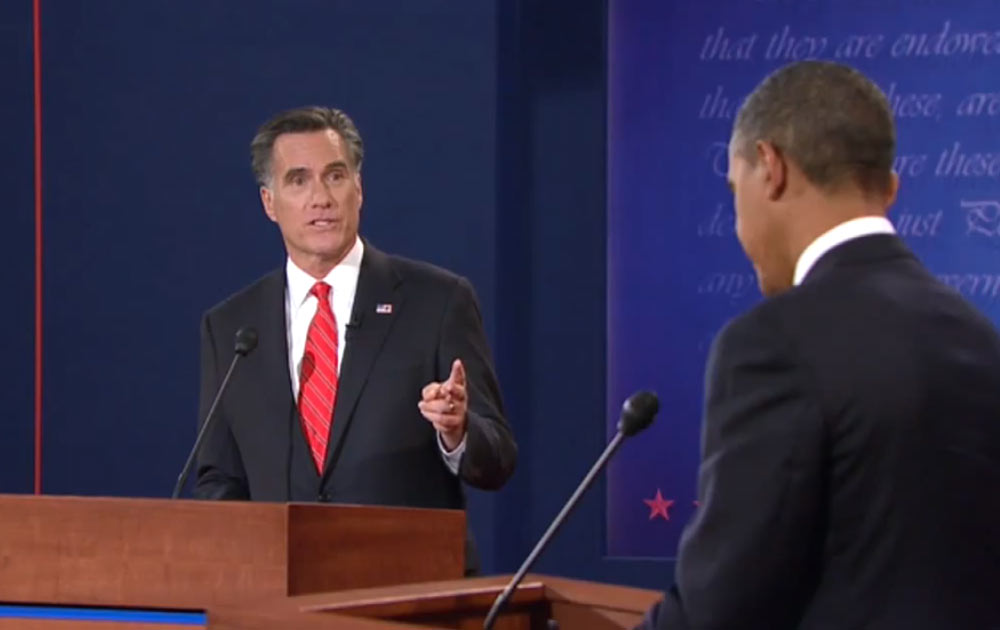Contrast in Body Language Defined Presidential Debate

Last night's presidential debate may not have been about words. The candidates' physical behavior, including their gestures and expressions, made the impression that will last, according to anthropologist David Givens.
"If you turn off the sound, you will feel or see what most Americans are feeling or seeing. If you turn the sound back on, the words get in the way of the nonverbal," Givens said. "You can't identify what the cues are."
It's this mute version of the debate that sticks with people, said Givens, director of the private, nonprofit Center for Nonverbal Studies in Spokane, Wash. "They remember body language, gestures, mannerisms and facial expressions."
Givens' overall impression matched the dominant perceptions circulating today (Oct. 4): Gov. Mitt Romney came across as aggressive, while President Barack Obama was more cerebral and cool — a difference widely perceived to have worked in the Republican challenger's favor.
Another expert in nonverbal communication, Karen Studd, a movement analyst at George Mason University, has been keeping an eye on both candidates' characteristic styles. [Quiz: Bizarre U.S. Presidential Elections]
Romney made vertical, predominantly up-to-down eye movements, a style that could be seen as connected to a top-down, authoritative approach.
Toward the end of the debate, Romney's hyperactive head nods worried Givens, who said he perceived them as aggressive.
Sign up for the Live Science daily newsletter now
Get the world’s most fascinating discoveries delivered straight to your inbox.
"To me that is a little scary to use a lot of physical aggression for political messages," he said.
Romney's strongly masculine appearance, particularly his compressed lips and eyebrows sitting low over his eyes, may convey the impression of anger even if the man himself does not feel it, Givens said.
While Romney, a direct guy who prefers to focus on a single person or idea, occupies vertical space, Studd told LiveScience that Obama has a more inclusive focus, preferring to take in the whole rather than a single piece of it, and he occupies space horizontally. The Democratic president's gestures, which have become more restrained over time, are horizontal, often open/close-type gestures, she said.
Givens noted that during the debate Obama put the pads of his thumb and index finger together when making a thoughtful point. This gesture, called a precision gesture, is an indication of some internal deliberation, Givens said. He did not see Romney make this gesture. [10 Oddball Facts About a Man's Brain]
"I would say that Obama was actually thinking during parts of the debate, but it seemed to me that Romney was more scripted, that he had said these things before and practiced saying them rather than making them up extemporaneously," Givens said.
Obama's appearance is not as strongly masculine as Romney's; the president has some more feminine traits, Givens said, such as fuller lips and a round-looking head, as well as childlike traits, particularly his protruding ears. These make Obama appear more approachable and less aggressive, Givens said.
His body languagealso can be friendlier than Romney's; for instance, Givens noted Obama made friendly palm-up gestures and head tilts during the debate.
Studd noted that whether one candidate's characteristic patterns are positive or negative depends on who is making the judgment.
"What you are seeing is movement reflects values, it reflects our worldview," Studd said. "If we don't think alike, I will be looking at your movements and thinking that doesn't seem right."
Studd has watched the candidates' styles evolve through prior debates, and she said that before last night Obama appeared more comfortable in his own skin, "but in this debate Romney seemed the more comfortable in some ways."
Studd and Givens agreed that the format for last night's debate, in which each man stood behind a podium and interacted with the other or with the moderator, benefited Romney.
Three more presidential debates are scheduled, including one in a town hall format Oct. 16 in which the audience will ask questions. This will be a better venue for Obama, Givens said: "He is more personable, and he can connect with people across a distance with his body language."
The format is likely to put Romney at a disadvantage because of perceived stiffness — a trait Givens attributes to Romney's habit of turning his entire torso, rather than just his head, to face someone. During last night's debate, however, this habit was not visible.
Follow LiveScienceon Twitter @livescience. We're also on Facebook & Google+.










